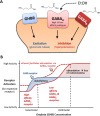Sodium Oxybate for Narcolepsy: Explaining Untoward Effects and Recommending New Approaches in Light of Prevailing Receptor Pharmacology
- PMID: 34860897
- PMCID: PMC5990161
- DOI: 10.1177/8755122514545518
Sodium Oxybate for Narcolepsy: Explaining Untoward Effects and Recommending New Approaches in Light of Prevailing Receptor Pharmacology
Abstract
Objective: Gamma-hydroxybutyrate (GHB) has been an abused and illicit substance for decades, but the antinarcoleptic medication Xyrem (sodium oxybate), the sodium salt of GHB, was approved just in 2002 for increasing wakefulness. We present a case of coma induced by co-ingestion of prescription GHB and ethanol and describe the response to naloxone treatment, by first responders, without evidence of opiate exposure. The purpose of this report is to bridge updated knowledge on GHB and ethanol pharmacology with the clinical sequence of events in a patient co-ingesting these compounds and to theorize on a potentially better pharmacological approach to narcolepsy. Case Summary: The patient was a 25-year-old woman with a history of narcolepsy. She suddenly collapsed at home but became transiently responsive after being administered naloxone in the ambulance. She presented to the emergency department with apnea, poor responsiveness with a Glasgow Coma Score of 7, and urinary incontinence. While undergoing intubation, the patient spontaneously and abruptly awoke. Labs were unremarkable except a blood alcohol concentration of 0.123%. The dosage of, and adherence to, GHB was unknown in this case. Discussion: The case is described in light of the most recent pharmacological advancements on these co-ingestants. A conceptual dose-response curve is shown to facilitate understanding of the complex pharmacology of GHB. Conclusions: Approved and potential alternatives to GHB, for achieving wakefulness, are discussed. Potential new strategies should bear low to no risk of coma with accidental overdose or co-ingestion of ethanol. In addition, promising antidotes for future consideration are discussed.
Keywords: GHB; Xyrem; gamma-hydroxybutyrate; naloxone; narcolepsy; oxybate; toxicology.
© The Author(s) 2014.
Conflict of interest statement
Declaration of Conflicting Interests: The author(s) declared no potential conflicts of interest with respect to the research, authorship, and/or publication of this article.
Figures

Similar articles
-
Illicit gamma-hydroxybutyrate (GHB) and pharmaceutical sodium oxybate (Xyrem): differences in characteristics and misuse.Drug Alcohol Depend. 2009 Sep 1;104(1-2):1-10. doi: 10.1016/j.drugalcdep.2009.04.012. Epub 2009 Jun 2. Drug Alcohol Depend. 2009. PMID: 19493637 Free PMC article. Review.
-
GHB levels in breast milk of women with narcolepsy with cataplexy treated with sodium oxybate.Sleep Med. 2017 Aug;36:172-177. doi: 10.1016/j.sleep.2017.05.008. Epub 2017 Jun 1. Sleep Med. 2017. PMID: 28668666
-
The Xyrem risk management program.Drug Saf. 2004;27(5):293-306. doi: 10.2165/00002018-200427050-00002. Drug Saf. 2004. PMID: 15061684 Review.
-
GHB pharmacology and toxicology: acute intoxication, concentrations in blood and urine in forensic cases and treatment of the withdrawal syndrome.Curr Neuropharmacol. 2015 Jan;13(1):47-70. doi: 10.2174/1570159X13666141210215423. Curr Neuropharmacol. 2015. PMID: 26074743 Free PMC article. Review.
-
Clinical applications of sodium oxybate (GHB): from narcolepsy to alcohol withdrawal syndrome.Eur Rev Med Pharmacol Sci. 2015 Dec;19(23):4654-63. Eur Rev Med Pharmacol Sci. 2015. PMID: 26698265 Review.
Cited by
-
Current knowledge on the pathophysiology of idiopathic hypersomnia and potential mechanisms of action for low-sodium oxybate treatment.J Clin Sleep Med. 2025 Jul 1;21(7):1245-1260. doi: 10.5664/jcsm.11566. J Clin Sleep Med. 2025. PMID: 39912238 Review.
References
-
- Bessman SP, Fishbein WN. Gamma-hydroxybutyrate, a normal brain metabolite. Nature. 1963;200:1207-1208. - PubMed
-
- Andriamampandry C, Taleb O, Kemmel V, Humbert JP, Aunis D, Maitre M. Cloning and functional characterization of a gamma-hydroxybutyrate receptor identified in the human brain. FASEB J. 2007;21:885-895. - PubMed
-
- Castelli MP, Ferraro L, Mocci I, et al. Selective gamma-hydroxybutyric acid receptor ligands increase extracellular glutamate in the hippocampus, but fail to activate G protein and to produce the sedative/hypnotic effect of gamma-hydroxybutyric acid. J Neurochem. 2003;87:722-732. - PubMed
-
- Bay T, Eghorn LF, Klein AB, Wellendorph P. GHB receptor targets in the CNS: focus on high-affinity binding sites. Biochem Pharmacol. 2014;87:220-228. - PubMed
Publication types
LinkOut - more resources
Full Text Sources
